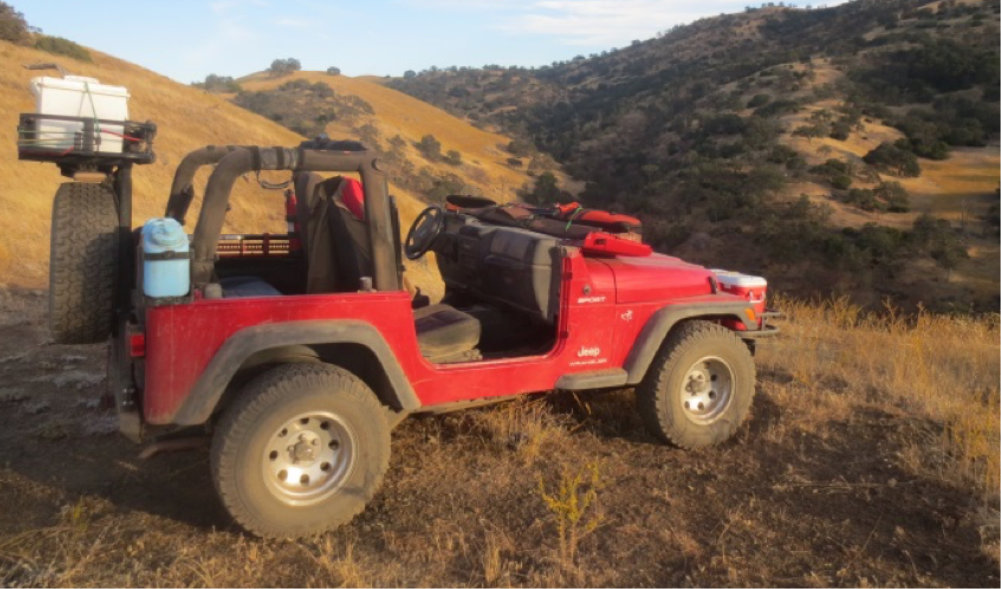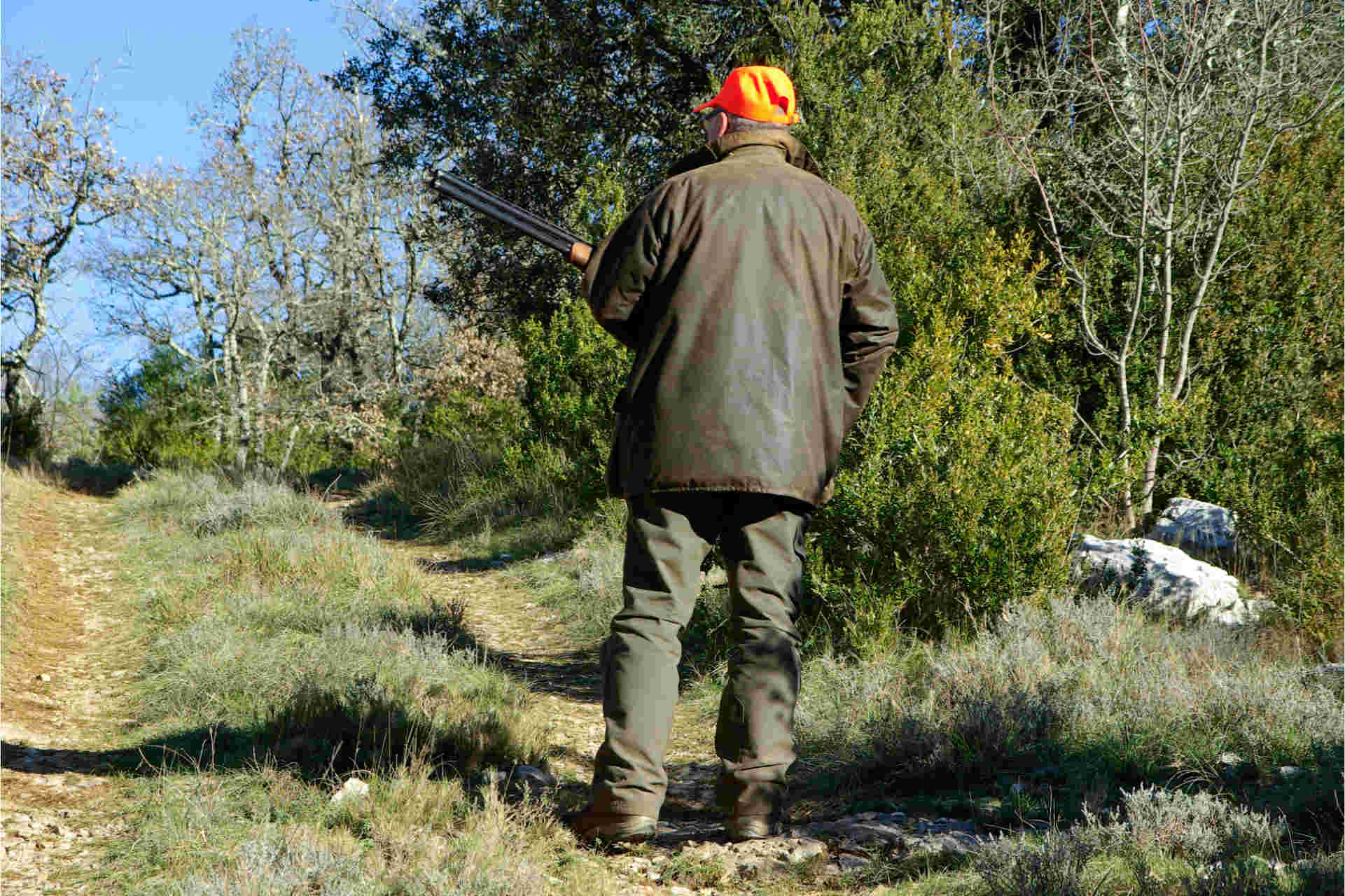Going Out
We will hunt at first light and will also
be hunting at the end of the day until it gets dark.

We will hunt at first light and will also be hunting at the end of the day until it gets dark. Legal shooting light is one half hour before sunrise to one half hour after sunset. We want to be in a prime location during those times. Most of the pigs are seen in the morning from first light to mid-morning, and again as shadows get long in the late afternoon until very last light. We have seen pigs all through the day, but most are in the mornings and evenings.
In the middle of the day, we can explore and go looking for pigs in remote places, or hunt for quail, etc., and always be looking for coyotes… Sometimes we go back to camp and relax for a while, or even grab a nap.
First thing in the morning, we will get up early so that we can have time for preparing, having some wake-up time, some coffee or tea, a snack, whatever, before getting going. I will let you know the night before when the preferred “wheels up” time will be depending on sunrise and where we want to be. That would be the ideal time to be in the rig and rolling. Sometimes when it is time to go, we have ‘that one more thing we need’, or ‘that thing we forgot’ … trust me, it happens to all of us. It is OK. We are having a good time and do not want to feel stressed. I do try and carry extras of most necessities. First and last light is best for boar, but we get there when we get there and somehow it always works out just fine.
We will be spending a lot of time out of doors. Some of the time we will be cruising in a 4x4 truck or open-air jeep, sometimes we will be walking, and sometimes we will be sitting and watching an area. We can vary the nature of the hunting from mostly driving to mostly hiking depending upon what is most enjoyable, what will be most productive for the circumstances, etc. We may want to cover lots of ground, but we may also want to focus on certain areas and hike down through where we may bump a guy out of his hiding place. We may split into groups. We do have some good two-way radios for when we separate. We also have hand signals:
- Index and second finger pointing at eyes means “I see” Can also add obvious signals for “I hear” and “I smell”
- Hands on breast is female
- Hands on crotch is male
- Down signal is obvious, get down be quiet!
- Directional pointing and other universal signals are obvious as well
Off we go for the morning hunt and we will probably be driving slow and quiet with windows open and looking everywhere. We may be hunting immediately, or we may be leaving a bit earlier and running in the dark for another place, to be there at first light.
Similarly, when we leave for the evening hunt, we will leave when we have one or two (or more) hours left of light, and hunt toward where we think will be the best place to be at last light. When we leave depends on how long it will take us to be where we want to be. We can literally drive for over an hour on the property just to get somewhere.
We will cruise trails looking for the pigs in meadows and on hillsides. At certain times of the year, we will pay close attention to water holes. That said, pigs love water and mud and moist earth all of the time. They love acorns. When we see them, we will look to see if we can identify a pig that might be a shooter, and whether we can get close enough for a shot. All shots are at the guide’s discretion. We prefer to shoot within distances not exceeding 100-200 yards and we prefer taking the males because the females make the babies! We don’t shoot big breeding sows, or sows with piglets. Smaller pigs of either sex make for the best eating.
There are plenty of places where we can get out and hike and look for pigs. There are many places where it would be productive to just sit quietly and watch for pigs, and we can drive on back roads and trails looking for pigs literally from sunup to sundown. We can do any mix of the above depending on the situation.

The pigs are always moving. We will see little dark things that might be pigs all over the place. If they are not moving, they are likely logs, rocks, bushes or shadows. We stop and look at those logs, rocks, bushes and shadows through the binoculars all the time! We see lots of cattle, and the calves can sometimes seem like pigs because they are running around. You will find that the cattle have a generally different body shape, obviously larger but also with square backsides. The pigs are smaller than the cattle and are larger in the fronts than the backs. Their backsides appear rounded off as compared to the cows.
Sometimes we see the pigs mixed in right amongst the cattle. Deer on the other hand seem to avoid the cows. I think it is because the cows make noise and aromas that interfere with the deer’s ability to sense danger. I think the deer just prefer to be away. The pigs are oblivious to the cattle, and once mature, they really don’t worry about predators at all.
A group of pigs is called a “sounder” of pigs, usually with one or more large females in charge. If we see a large solo pig, it is most often a boar. They do tend to be solo most of the year, while at other times, obviously, they are not far from the females. There are opinions as to when those times of the year may be.
The females are dangerous and protective. The males can be very dangerous as well. We have seen a boar charge for no apparent reason. A poorly shot boar or sow will very often try and charge at you when you get near it. Do not ever enter dense brush and do not ever walk in high grass if there are pigs around. A startled pig is a dangerous/deadly pig. Be aware of animal sign, sounds and smells. The pigs have a distinct and pungent odor. You can smell a pig if you get downwind of it and are close enough. If enough pigs stay in one area for any period of time they will leave behind an odor. Use all of your senses. We have backed out of tight situations where we could
sense a dangerous pig, and I am sure it was the best thing to do. If we shoot a boar at last light and he goes into the bush, we will wait until morning to get him out.
The wind is so important. With a good wind, we can sometimes get as close to the pigs as we want. It is amazing how they are so oblivious (or unconcerned) when they cannot smell us. They can see, just not all that well. They surely do see motion. They can also hear, but the wind helps (or hurts) with that, too. If we identify a pig we want to shoot, we will get ready, get into range as best as possible, set up the shooting sticks or some other option/position, and fire.

Things to bring:
- Both warm and cool clothes, layers are ideal.
- Camo is fun but not required (unless we are hunting turkeys.) I sometimes wear camo pants or shirts. I like pants with cargo pockets.
- Blaze Orange of some sort is a good idea. I often wear an orange hat or orange band on a hat.
- A daypack is handy for water and stuff when we walk. I recommend everyone have a backpack even if just to keep all your stuff together in the truck or Jeep.
- A brimmed hat is a must in the summer, as well as sunscreen and chapstick
- Comfortable hiking boots, (7-8″ or taller boots are ideal to avoid burrs getting into socks, etc.)
- Gators also help with grass burrs and also with wet grass and tarweed.
- Camp shoes are great for when you don’t want your boots on. Slip-ons. Maybe even flip flops.
- Personal items.
- Your preferred evening beverage.
- You will definitely need a flashlight and headlamp. (I like models that use normal AA batteries or rechargeable 18650 batteries.)
- Bring binoculars if you have them. It is definitely good to have binoculars.
- Same goes for a spotting scope. Bring one if you have one – we will use it.
I have one. - I am also a believer in shooting sticks. I have them but you are welcome to bring your own.
- I also always carry some orange surveyor tape, a loud whistle and a signal mirror in a pocket along with a bic lighter and swiss army knife.
- License, tag, rifle and lead free ammo
- Game bag, tarp
- Ear protection
- Sleeping bag (if not at the lodge)
- Be mindful that away from the lodge, there is no power. CPAP users need alternate power.
